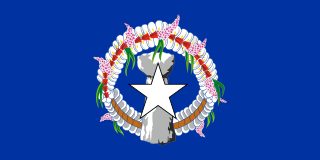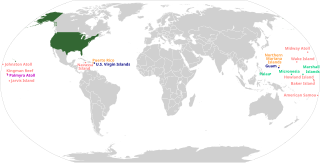 |
|---|
A referendum on becoming a US commonwealth was held in the Northern Mariana Islands on 17 June 1975. [1] The proposal was approved by 79% of voters. [1] As a result, the United States Congress approved the change of status on 24 March 1976. [1]
 |
|---|
A referendum on becoming a US commonwealth was held in the Northern Mariana Islands on 17 June 1975. [1] The proposal was approved by 79% of voters. [1] As a result, the United States Congress approved the change of status on 24 March 1976. [1]
Four previous referendums on either integration with Guam or the islands' status had been held in 1958, 1961, 1963 and 1969. On each occasion a majority of Northern Mariana Islands voters had been in favor of integration with Guam, but Guamanian voters rejected integration in a 1969 referendum.
On 20 February 1975 the Northern Marianas' District Legislature put forward proposals to become a US commonwealth. [1] A threshold of 55% in favor was set in order for the referendum to pass. [1]
| Choice | Votes | % |
|---|---|---|
| For | 3,945 | 78.82 |
| Against | 1,060 | 21.18 |
| Invalid/blank votes | 4 | – |
| Total | 5,009 | 100 |
| Registered voters/turnout | 5,379 | 93.12 |
| Source: Direct Democracy | ||
The history of Guam starts with the early arrival around 2000 BC of Austronesian people ent American rule of the island began with the 1898 Spanish–American War. Guam's history of colonialism is the longest among the Pacific islands.
Guam is a two-party presidential representative democracy, in which the Governor is the head of government. Guam is an organized, unincorporated territory of the United States, with policy relations between Guam and the US under the jurisdiction of the Office of Insular Affairs.

The Northern Mariana Islands, officially the Commonwealth of the Northern Mariana Islands, is an unincorporated territory and commonwealth of the United States consisting of 14 islands in the northwestern Pacific Ocean. The CNMI includes the 14 northernmost islands in the Mariana Archipelago; the southernmost island, Guam, is a separate U.S. territory. The Northern Mariana Islands were listed by the United Nations as a non-self governing territory until 1990.

The 51st state is a term in American political discourse that refers to areas considered to be candidates for U.S. statehood, joining the 50 United States existing since 1959. The phrase has been applied to external territories, as well as the country's capital for the District of Columbia and parts of already-existing states which would be admitted as separate states in their own right.
Commonwealth is a term used by two unincorporated territories of the United States in their full official names, which are the Northern Mariana Islands, whose full name is Commonwealth of the Northern Mariana Islands, and Puerto Rico, which is named Commonwealth of Puerto Rico in English and Estado Libre Asociado de Puerto Rico in Spanish, translating to "Free Associated State of Puerto Rico." The term was also used by the Philippines during most of its period under U.S. sovereignty, when it was officially called the Commonwealth of the Philippines.
In the United States, each state has its own written constitution.

General elections were held in the Commonwealth of the Northern Mariana Islands (CNMI) on Saturday, 5 November 2005, electing the governor and Legislature. There was also a referendum on calling a Constitutional Convention, which was approved by voters. The gubernatorial election was the closest in the commonwealth's history, and resulted in the election of Benigno Fitial, narrowly defeating independent Heinz Hofschneider by 84 votes and incumbent Republican Governor Juan N. Babauta by an additional 98 votes.
A referendum on union with the Northern Mariana Islands was held in Guam on 4 November 1969. The proposal was rejected by 58% of voters due to fears about an increase in taxation. Despite the result, a similar referendum was held in the Northern Mariana Islands on 9 November in which 61% of voters supported union with Guam.

An unofficial referendum on integration of Northern Marianas with Guam was held in Saipan in June 1958. Though the proposal was approved by nearly 64% of voters and the Guam Legislature adopted Resolution No. 367 requesting the US Congress to integrate the governments, the United States did not integrate the islands.

An unofficial referendum on integration with Guam was held in the Northern Mariana Islands on 27 October 1963. Although the proposal was approved by voters, the islands were not integrated.

A referendum on the status of the Northern Mariana Islands was held on 5 February 1961. Although 65% of voters supported integration with Guam, the United States did not integrate the islands.

A referendum on the status of the Northern Mariana Islands was held on 9 November 1969. For the fourth time since 1958 a majority of voters supported integration with Guam. However, a referendum held in Guam on 4 November on integration with the Northern Mariana Islands had been rejected by 58% of Guamanian voters.

A referendum on holding a Constitutional Convention was held in the Northern Mariana Islands on 5 November 1983. The proposal was approved by voters. A subsequent 44-part referendum on constitutional amendments was held in 1985.

A three-part referendum was held in the Northern Mariana Islands on 6 November 1993. Voters were asked whether they approved of two constitutional amendments regarding collective land ownership of native islanders and the veto powers of the Governor, and whether a Constitutional Convention should be elected. All three proposals were approved by voters.

A constitutional referendum was held in the Northern Mariana Islands on 6 November 1995. Voters were asked whether they approved of two proposed amendments to the constitution; one limiting the rights to vote on constitutional amendments that affected land ownership to native islanders, and one on establishing an Office of Finance to regulate the spending of the Legislature. The first proposal was approved by voters and the second rejected.
A constitutional referendum was held in the Northern Mariana Islands on 6 November 2012, alongside the election for the islands' representative to the United States House of Representatives. Voters were asked whether they approved of three proposed amendments to the constitution. All three were approved.

General elections were held in the Northern Mariana Islands on November 4, 2014. Voters elected the Governor of the Northern Mariana Islands, the Lieutenant Governor, the Attorney General, the Delegate to the US Congress, the Senate, the House of Representatives, mayors, municipal councils and the Board of Education. Additionally, a referendum involving changes to the constitution was held.
The Marianas Political Status Commission was a body composed of representatives of the Northern Mariana Islands who negotiated the political status of the Northern Mariana Islands from December 1972 until February 1975. The Commission negotiated with a delegation from the U.S. federal government, led by the Personal Representative of the President of the United States, Ambassador F. Haydn Williams, during talks which spanned 27 months. The negotiations resulted in the Covenant to Establish a Commonwealth of the Northern Mariana Islands in Political Union with the United States of America.
The CNMI Cannabis Act of 2018 is a bill introduced in the Northern Mariana Islands Commonwealth Legislature in 2017 as SB 20-62. It was introduced by Senator Sixto Igisomar and would legalize cannabis possession and consumption by adults and create a Cannabis Commission to regulate sales in the Commonwealth. Hearings on the act were held in October, 2017; a senator said it had the highest public attendance of any hearings he knew of. On May 16, 2018, SB 20-62 had a final vote in the Commonwealth's Senate, and was passed without opposition. On May 30, it passed the House Committee on Judiciary and Governmental Operations unanimously.
The Marianas archipelago of the Northern Pacific contains fourteen islands located between Japan and New Guinea on a north–south axis and Hawaii and the Philippines on an east–west axis. Inhabitants were Spanish nationals from the 16th century until the Spanish–American War of 1898. As Guam became a territory of the United States the Northern Marianas were sold to Germany in 1899. The Northern Mariana Islands were a German protectorate until 1919, when they became part of the South Seas Mandate, administrated by Japan. At the close of World War II, the Marianas became part of the Trust Territory of the Pacific Islands. In 1975, the Commonwealth of the Northern Mariana Islands became a self-governing territory. In 1986, the Marianas came under the sovereignty of the United States when the trusteeship ended and US nationality and citizenship was conferred on the inhabitants of the territory.